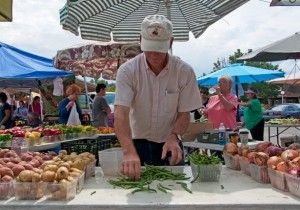Local markets grow healthy community

September 3, 2013
Farmers markets are helping to pump up the local economy and put nutricious produce into people’s bodies.
Over the past decade, farmer’s markets have seen a steady increase in popularity. According to the U.S. Department of Agriculture, there were 1,755 farmers markets in 1994 and 7,864 last year. Between 2011 and 2012 alone the USDA reported a 9.6 percent increase in the number of farmers markets in the U.S.
Advertisement
Ann Stahlheber, manager of the Carbondale market, has an explanation for the rise in popularity. She says the public has become more aware of what they’re putting into their bodies every time they sit down for a meal and they want to know as much as they can about where their food comes originates.
“People here get to know the farmers. They get to know who grows their food. That’s important to them,” she said.
One of those farmers, Vina Pedigo- Young, has also noticed the increased interest in local foods. She and her parents, Judy and Doug Pedigo, sell a variety of plants, herbs, fruits and vegetables, all of which they grow on their Dongola farm and orchard.
The family has been selling their goods at the Carbondale market more than 30 years, and in that time they’ve had to adjust their growing methods to keep up with demand.
“We have six greenhouses for the plants and multiple hoop houses for the vegetables and flowers,” Pedigo-Young said between helping customers.
She said the greenhouses and hoop houses are constructed of plastic sheeting stretched over a series of arches, and help them increase their yield and provide vegetables at times when they would otherwise be unavailable.
Knowing where your food comes from isn’t the only perk to shopping at the farmer’s market.
Advertisement*
Alan Walters, professor of vegetable science at SIU, said vegetables grown locally are likely more nutritious than those grown elsewhere and shipped here.
Tomatoes, he says, are a prime example of vegetables that are healthier when purchased locally. Most of the tomatoes sold in Illinois are grown many miles away in places like Florida, Texas, California and Mexico. Because they are grown so far away, they are picked at the mature green stage and allowed to ripen off the vine.
Students in Walters’s classes are researching the difference in nutrient content between tomatoes harvested green and those allowed to ripen on the vine. Their studies indicate tomatoes picked green have less Vitamin C and lycopene an antioxidant linked to reduced risk of cancer, heart disease and macular degeneration than are vine-ripened ones.
Walters said the implications are pretty clear.
“You ship a tomato, you pick it green in California, you ship it to Chicago, they hold it in storage then they gas it with ethylene to ripen it,” he said. “Then you get this red tomato that doesn’t have as much nutrient content as one that you’ve harvested locally the day before.”
He added that fruits begin to lose nutrients the moment they leave the plant, so the longer something sits on a truck or in refrigeration, the less nutritional value it has.
Walters also warned that what’s on the outside of your produce is often just as important as what’s on the inside. Extraneous chemicals such as insecticides, herbicides and fungicides are often found clinging to some of the most heavily consumed produce, including apples, celery and lettuce.
The precise effects of these chemicals on the human body are not yet entirely understood, but Walters suggests people minimize their intake of pesticides.
Two of the dirtiest fruits found in supermarkets are strawberries and imported grapes, so Walters suggests buying ones that are produced locally.
Because strawberries are especially prone to molds, many have been found to contain up to 13 different pesticides. Local growers can often use fewer chemicals on their strawberries because they can get them to the consumer much faster, Walters said.
Buying local produce isn’t just good for consumers; it can also help the environment.
“It takes 1,600 miles to take a piece of produce from where it’s produced to the supermarket shelf. That’s a lot of carbon units,” Walters said, referring to the fossil fuels it takes to transport produce from farm to table.
Choosing local foods, especially those produced with fewer fertilizers and pesticides, is a good way to shrink carbon footprints, Walters said.
Although local produce is what brings most people to the market, Stahlheber said the Carbondale market has a unique variety of non-produce vendors, all of whom produce their goods in the region.
Advertisement








